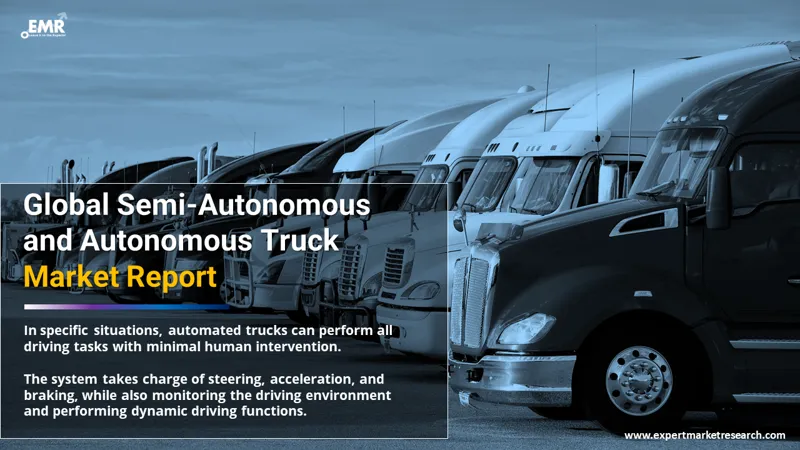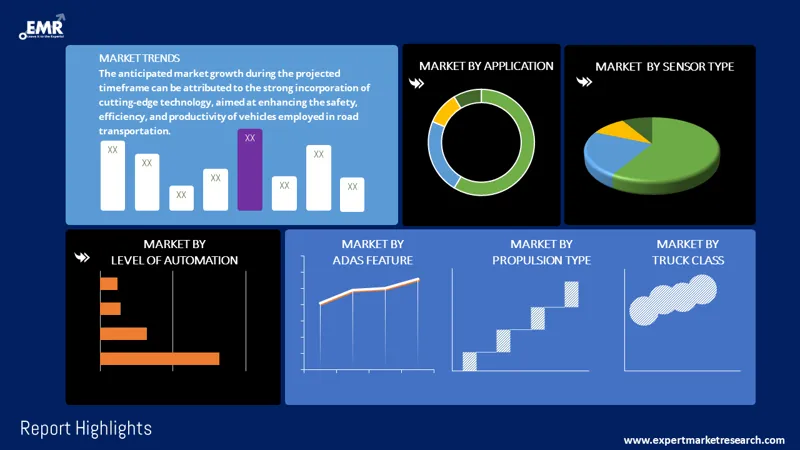
Consumer Insights
Uncover trends and behaviors shaping consumer choices today
Procurement Insights
Optimize your sourcing strategy with key market data
Industry Stats
Stay ahead with the latest trends and market analysis.
The global semi-autonomous and autonomous truck market is expected to grow in the forecast period of 2026-2035 at a CAGR of 27.50%.
Base Year
Historical Period
Forecast Period
Compound Annual Growth Rate
27.5%
2026-2035
*this image is indicative*
The Asia Pacific is expected to witness a robust growth in the forecast period. This can be associated with China and Japan's rapid progress toward vehicle automation, especially mining and delivery trucks, and increasing safety regulations by various countries. The Asia Pacific is expected to be one of the fastest-growing regions in both the semi-autonomous and autonomous truck industry during the forecast period.
South Korea's Transport Ministry has mandated autonomous emergency braking and lane departure warning systems in passenger cars beginning from January 2019 and in trucks and other vehicles starting from July 2021. Meanwhile, North America is a pioneer in autonomous technology, pickup trucks, which are equipped with innovative semi-autonomous features. The leading automotive manufacturing companies such as Ford and General Motors are increasingly providing pickup trucks services in the region. These factors are expected to aid the global semi-autonomous and autonomous truck industry in the forecast period.

Read more about this report - REQUEST FREE SAMPLE COPY IN PDF
Automated trucks can do all the driving with minimal human interference in certain circumstances. The system controls the steering, acceleration, and braking, further monitoring the driving environment, along with dynamic driving tasks. On the other hand, in the case of semi-autonomous trucks, the driver is responsible for driving the vehicle while the technology is utilised to provide the driver with advanced safety features.
By sensor type, the market can be distributed into
The market can be broadly categorised, on the basis of application, into
On the basis of ADAS feature, the market can be segregated into
On the basis of level of automation, the market can be segmented into
Based on propulsion type, the market can be classified into
On the basis of truck class, the market can be divided
The regional markets for the product include

Read more about this report - REQUEST FREE SAMPLE COPY IN PDF
Autonomous trucks provide improved safety, efficiency, and productivity and offer the potential to drastically reduce the frequency of road accidents. These vehicles observe the road safety rules and maintain a safe distance from other vehicles. These trucks, thus, assist in reducing the issues of traffic congestion while also increasing vehicle efficiency. Additionally, major corporations can reduce their total costs by utilising autonomous last-mile delivery trucks. Another major factor, which is expected to drive the demand for autonomous trucks for last-mile delivery applications is the reduced availability of delivery drivers and staff, as well as an increase in e-commerce activities. In addition, the increased logistic activities are also projected to lead to the growth of the semi-autonomous and autonomous truck industry in the forecast period.
The report presents a detailed analysis of the following key players in the global semi-autonomous and autonomous truck market, looking into their capacity, market shares, and latest developments like capacity expansions, plant turnarounds, and mergers and acquisitions:
The comprehensive report looks into the macro and micro aspects of the industry. The EMR report gives an in-depth insight into the market by providing a SWOT analysis as well as an analysis of Porter’s Five Forces model.




*While we strive to always give you current and accurate information, the numbers depicted on the website are indicative and may differ from the actual numbers in the main report. At Expert Market Research, we aim to bring you the latest insights and trends in the market. Using our analyses and forecasts, stakeholders can understand the market dynamics, navigate challenges, and capitalize on opportunities to make data-driven strategic decisions.*
Get in touch with us for a customized solution tailored to your unique requirements and save upto 35%!
The global semi-autonomous and autonomous truck market is projected to grow at a CAGR of 27.50% between 2026 and 2035.
The rising use of semi-autonomous and autonomous trucks in the logistics industry for the delivery of goods to increase efficiency is driving the market growth.
The market growth in the forecast period can be ascribed to the robust integration of advanced technology to improve safety, efficiency, and productivity of the vehicles used in road transportation.
The major regions in the industry are North America, Latin America, the Middle East and Africa, Europe, and the Asia Pacific.
The market segmentations based on sensor types are LiDAR, radar, image, and ultrasonic, among others.
The major applications of semi-autonomous and autonomous truck include last mile delivery truck and mining truck.
The significant ADAS features of semi-autonomous and autonomous truck are adaptive cruise control (ACC), automatic emergency braking (AEB), blind spot detection (BSD), intelligent park assist (IPA), lane keep assist (LKA) traffic jam assist (TJA), and highway pilot (HP).
The different levels of automation of semi-autonomous and autonomous truck are level 1, level 2 and 3, level 4, and level 5.
The various propulsion types of semi-autonomous and autonomous truck are diesel, electric, and hybrid.
The major truck classes of semi-autonomous and autonomous trucks include class 1-class 3 (light duty truck), class 4- class 6 (medium duty truck), and class 7 and class 8.
The major players in the industry are AB Volvo, Robert Bosch GmbH, Continental AG, NVIDIA Corporation, Tesla, Inc., and Embark Trucks, Inc., among others.
Explore our key highlights of the report and gain a concise overview of key findings, trends, and actionable insights that will empower your strategic decisions.
| REPORT FEATURES | DETAILS |
| Base Year | 2025 |
| Historical Period | 2019-2025 |
| Forecast Period | 2026-2035 |
| Scope of the Report |
Historical and Forecast Trends, Industry Drivers and Constraints, Historical and Forecast Market Analysis by Segment:
|
| Breakup by Sensor Type |
|
| Breakup by Application |
|
| Breakup by ADAS Feature |
|
| Breakup by Level of Automation |
|
| Breakup by Propulsion Type |
|
| Breakup by Truck Class |
|
| Breakup by Region |
|
| Market Dynamics |
|
| Competitive Landscape |
|
| Companies Covered |
|
| Report Price and Purchase Option | Explore our purchase options that are best suited to your resources and industry needs. |
| Delivery Format | Delivered as an attached PDF and Excel through email, with an option of receiving an editable PPT, according to the purchase option. |
Datasheet
One User
USD 2,499
USD 2,249
tax inclusive*
Single User License
One User
USD 3,999
USD 3,599
tax inclusive*
Five User License
Five User
USD 4,999
USD 4,249
tax inclusive*
Corporate License
Unlimited Users
USD 5,999
USD 5,099
tax inclusive*
*Please note that the prices mentioned below are starting prices for each bundle type. Kindly contact our team for further details.*
Flash Bundle
Small Business Bundle
Growth Bundle
Enterprise Bundle
*Please note that the prices mentioned below are starting prices for each bundle type. Kindly contact our team for further details.*
Flash Bundle
Number of Reports: 3
20%
tax inclusive*
Small Business Bundle
Number of Reports: 5
25%
tax inclusive*
Growth Bundle
Number of Reports: 8
30%
tax inclusive*
Enterprise Bundle
Number of Reports: 10
35%
tax inclusive*
How To Order

Select License Type
Choose the right license for your needs and access rights.

Click on ‘Buy Now’
Add the report to your cart with one click and proceed to register.

Select Mode of Payment
Choose a payment option for a secure checkout. You will be redirected accordingly.
Gain insights to stay ahead and seize opportunities.

Get insights & trends for a competitive edge.

Track prices with detailed trend reports.

Analyse trade data for supply chain insights.

Leverage cost reports for smart savings

Enhance supply chain with partnerships.

Connect For More Information
Our expert team of analysts will offer full support and resolve any queries regarding the report, before and after the purchase.
Our expert team of analysts will offer full support and resolve any queries regarding the report, before and after the purchase.
We employ meticulous research methods, blending advanced analytics and expert insights to deliver accurate, actionable industry intelligence, staying ahead of competitors.
Our skilled analysts offer unparalleled competitive advantage with detailed insights on current and emerging markets, ensuring your strategic edge.
We offer an in-depth yet simplified presentation of industry insights and analysis to meet your specific requirements effectively.
Share